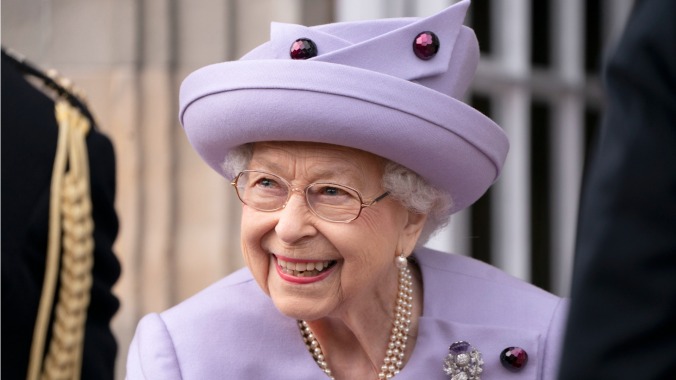R.I.P. Queen Elizabeth II, Britain's longest-ruling monarch
The Queen died on September 8 at the age of 96, Buckingham Palace confirms.

Queen Elizabeth II, who sat atop Britain’s monarchy for more than 70 years and is the second longest-ruling monarch in human history, has died, Buckingham Palace confirms via their official Twitter account. She was 96 years old.
Earlier today, a spokesperson for Buckingham Palace shared that the Queen’s doctors are “concerned for Her Majesty’s health and have recommended she remain under medical supervision.” They also shared the Queen was “comfortable and at Balmoral,” her Scottish estate— members of the royal family including her son, Prince Charles, and her sister, Princess Anne, quickly gathered at her side. The Queen had been consistently stepping back from public duties after swearing in new Prime Minister Liz Truss on Monday—her mobility had become limited after a bout of COVID-19.
Born on April 21, 1926 to King George VI and Queen Elizabeth the Queen Mother, it initially never seemed probable that Elizabeth II would take the throne. Her father had taken the reigns after his older brother Edward VII abdicated the crown in 1936 in order to marry American socialite Wallis Simpson, making Elizabeth II the throne’s heir apparent. In 1947 she wed her distant cousin Philip Mountbatten (who she remained married to until his death in 2021)— a year later, her first child, Charles, was born.
But just as Elizabeth II navigated the early days of motherhood, marriage and monarchy, she received a shove into the deep end in the form of her father’s February 1952 death. Elizabeth received word of his passing during a royal trip with Philip through Kenya—when she returned home to England, she returned as Her Majesty.
Throughout her extensive rule, the Queen dragged the old monarchy into the modern world, including allowing the royal family to interact via televised broadcast in 1970, as well as condoning her sister’s separation and divorce from her first husband in 1989 and 1992 respectively. A visit to Ireland she made in 2011 also marked one of the first visits by a British monarch to the country in 100 years.
The Queen’s monarchy journey saw some growing pains during Charles’ turbulent marriage to Princess Diana and subsequent divorce. Tensions between the monarchy’s perception of Diana and the adoration she received from the British people eroded the monarchy’s relationship with an already-skeptical public, especially after Diana’s death in 1997.
In 2015, the Queen officially surpassed Queen Victoria’s record-length time on the throne, becoming the longest-sitting ruler in British history. Shortly after Prince Philip resigned from public life in 2017, the Queen also began limiting her duties and appearances, passing many to grandson Prince William and his wife Kate, Duchess of Cambridge. Prince Harry and his wife Meghan, Duchess of Sussex also initially participated in royal duties until they themselves stepped away from the monarchy in 2020 to some controversy. One of the Queen’s final large-scale public events came in February of this year, when she celebrated her Platinum Jubilee to mark 70 years on the throne.
The Queen’s life has been chronicled in a myriad of cinematic adaptations—she has been portrayed by Helen Mirren, Emma Thompson, and even Fred Armisen. Netflix’s popular drama The Crown has chronicled her life (portrayed in chronological ages by Claire Foy, Olivia Colman, and Imelda Staunton) since 2016.